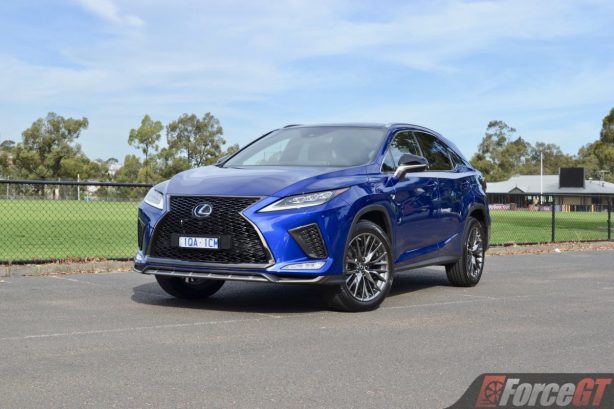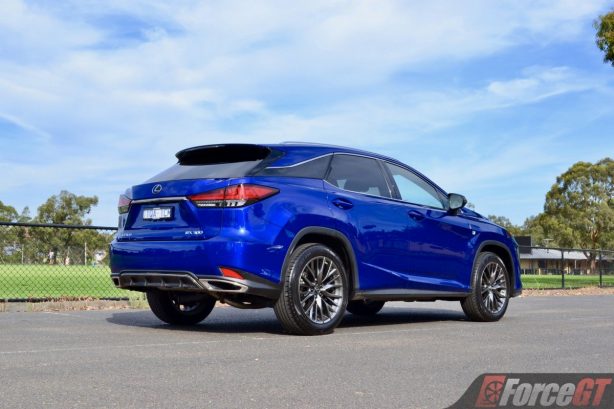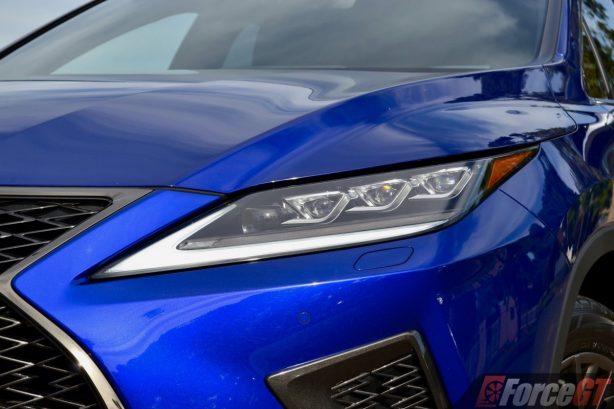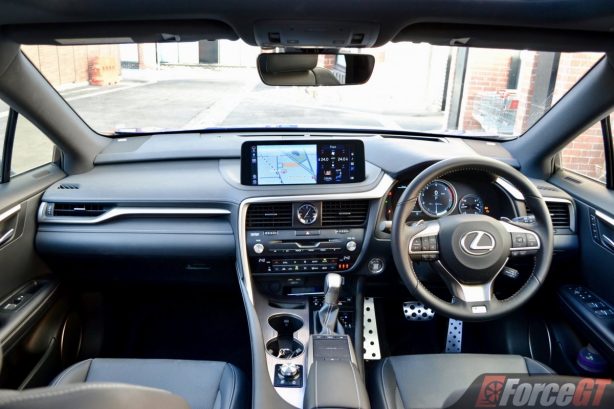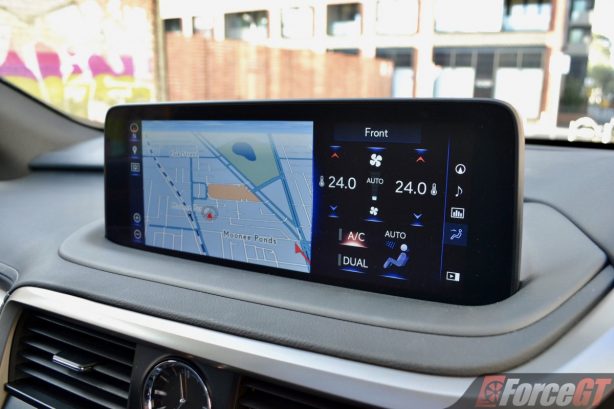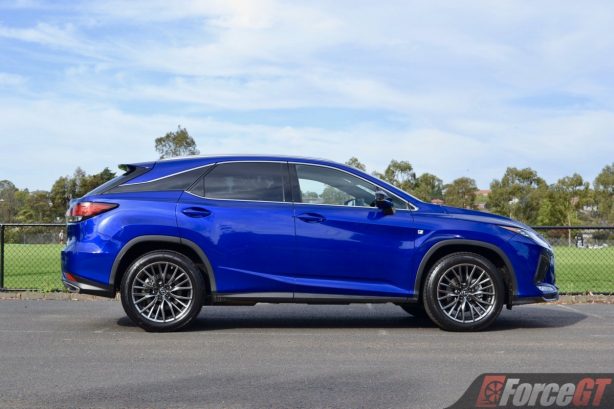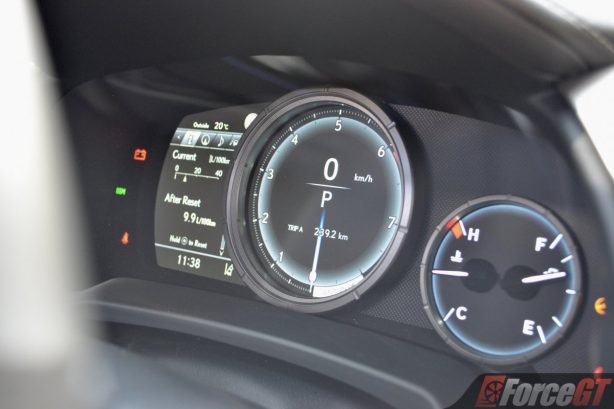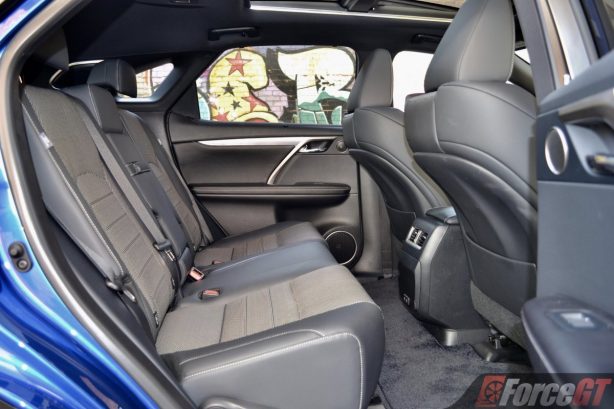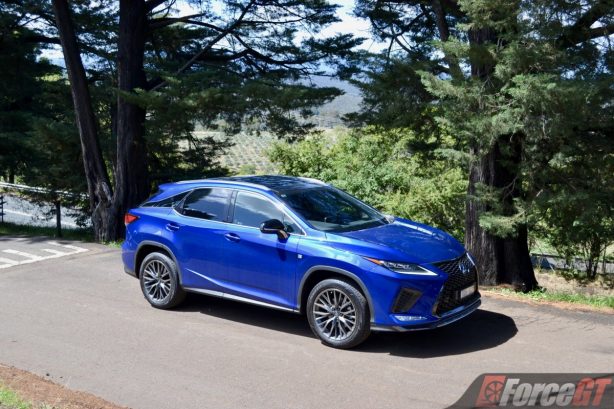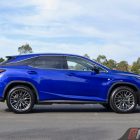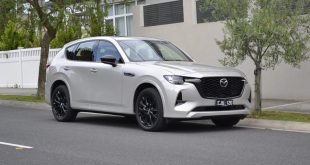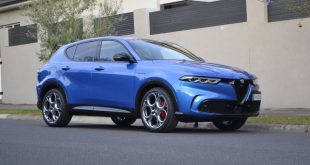When we first drove the current fourth-generation Lexus RX back in 2016, we liked its bold design, ride comfort and luxurious features. For 2020, Lexus has given the mid-size SUV a top-to-bottom refresh, with the aim of further boosting its appeal in this increasingly competitive passenger car segment.
The 2020 Lexus RX range offers connectivity and safety technology upgrades, as well as enhanced driving dynamics, teamed with a reduced entry price. The range now kicks off at $71,920 before on-road costs for the entry-level RX 300 Luxury – a reduction of $1,600 and further undercutting equivalent entry-level models of the BMW X5, Mercedes-Benz GLE and Jaguar F-Pace.
We were given the keys to the one grade up RX 300 F Sport which costs $86,800 plus ORCs. Let’s take a closer look.
What’s new for 2020?
The untrained eye may have a hard time picking out the changes to the RX exterior because they are only subtle. Nevertheless, a closer inspection will reveal the updated Lexus spindle grille, which now has a softer appearance thanks to the slimmer and curvier grille surround. Similarly, the sharp edges on those swept-back headlamps have also been slightly trimmed out for a cleaner, more elegant look.
Our F Sport model gets bespoke wire-mesh grille with darkened chrome grille surround and sportier front bumper with larger side intakes and a more pronounced bumper lip spoiler.
At the rear, the restyled taillight cluster has a darker surround and incorporates a new 3D-effect L-motif design for the brake lights and dynamic indicators. The rear bumper has also been updated with horizontally orientated reflectors and a revised diffuser design for a wider look.
As with the front, the F Sport variant gets dark chrome highlights on the rear number plate garnish as well as a deeper rear diffuser.
Overall, Lexus has done a commendable job rejuvenating the RX’s exterior, with the SUV still looking fresh and striking despite being four years into its life cycle.
It’s not all just cosmetics though, as the 2020 model makes first use of Lexus’ innovative LED adaptive high-beam system with blade-scan technology. Instead of pointing the LED lamps towards the road the lighting technology directs the lamps back towards a blade mirror rotating at an incredible 12,000rpm. The reflection of light off the spinning mirror is claimed to increase high-beam brightness and expand its reach down the road. It’s also designed to deliver more controlled light distribution for the most precise “shading” to avoid dazzling other drivers.
Fitted to all F Sport and Sports Luxury grades, the blade-scan lighting system did give a more spread out and even projection of light at night on test.
Inside, all new RX variants receive paddle shifters on the steering wheel and additional smartphone storage, but the biggest change is the 12.3-inch infotainment display which has been moved closer to the driver and can now be operated by touch as well as the touchpad-type Lexus Remote Touch system.
The Lexus interface has always been one of the more fiddly ones in the segment and the touchscreen is certainly welcomed. However the menu structure and buttons are unchanged from before, which means they aren’t quite optimised for touch – the menus are quite cluttered and the buttons are too small. We find ourselves sticking with the touchpad when on the move and only using touch when stationary.
Along with the move to a touchscreen, Apple CarPlay and Android Auto compatibility also make first introduction in the RX, while USB ports grew from 2 to 4 to give a total of 6.
In terms of safety, the Standard Lexus Safety System gains night-time pedestrian and daytime cyclist detection for the pre-collision safety system and autonomous emergency braking. Its all-speed active cruise control is now linked with new lane-trace assist and road-sign assist functionality.
How does it drive?
The RX 300 tested here is powered by a 2.0-litre four-cylinder turbocharged petrol engine. Unchanged from before, the engine produces 175 kW of power at 5600 rpm accompanied with 350 Nm of torque from 1650 rpm to 4000 rpm. Drive is channeled solely to the front wheels via a six-speed automatic transmission. For all-wheel drive you’ll have to step up to the V6-powered RX 350 or hybrid RX 450h.
While the 175kW of power may not seem like a lot for a near two-tonne SUV, it gets the job done for most things you throw at it. Off the line, the acceleration is brisk and on the move it feels effortless. The only time it struggles a little is when you have a full load going up a slope, where you wish it had 10 or so kilowatts more.
The six-speed auto is always eager to drop a few cogs when more power is called for, and while it does an excellent job keeping the engine spinning in its powerband, it can do with a couple more ratios (such as an eight-speed auto) on the freeway to keep the rpm low and fuel efficiency up.
But we get that it’s a Lexus and the RX does best at what the brand is renown for – refined, serene and relaxing motoring. The drivetrain is buttery smooth and whisper quiet at cruise, with the most seamless and least intrusive idle stop start system we have tested – for once there’s actually no need to switch this thing off.
Being an F Sport, the RX on test does have extra chassis stiffening and a slightly firmer suspension tune, but the ride is still very forgiving. It’s generally smooth and uneventful across most road surfaces, with it only getting lumpy on heavily rippled roads.
The 2020 update for the chassis is mainly dynamic focused. The standard adaptive variable suspension now operates over a wider range to further enhance comfort and control. There are new front and rear performance braces, along with improved hub bearings for the front and rear suspension, and a larger and lighter rear anti-roll bar.
Active cornering assist is now on all RX variants, suppressing understeer by gently braking the inside wheels, while a revised steering tune brings tighter on-centre feel.
Without driving the previous model back to back with this new one, it’s hard to tell how much of an improvement there is as a result of the update, but the RX F Sport feels composed and tidy on winding roads, responding well to driver inputs.
That said, a BMW X5 M Sport or Jaguar F-Pace R-Sport is still the better driver’s car with tauter dynamics and heightened engagement.
What’s it like to live with?
As with most Lexus models, the RX is an incredibly easy car to live with. It’s no doubt one of the most comfortable family SUVs in the premium segment, even in the more athletic F Sport trim.
The beautifully crafted F Sport seats are sumptuously comfortable, yet nicely supportive. The driving position is excellent, so is all round visibility. With seating for five, headroom and legroom is generous for all occupants. Those needing more seats can opt for the stretched RX L seven-seater variant, though it’s only available in V6 or hybrid forms.
The RX is also very practical, with clever storage compartments dotted around the cabin, including a new type of cup holder that adjusts to the height of the cup you place inside it.
Further aback, the electric tailgate opens up to 533 litres of boot space, expandable to 1626 litres with the rear seats folded.
What’s the running costs?
The RX 300’s average fuel consumption is rated at 8.1L/100km. On test, with over 500km of mixed urban, country and freeway driving, the trip computer reported 9.5L/100km, a fair way off the advertised figure but still respectable for a large crossover.
Being a Lexus, the RX benefits from its maker’s four-year/100,000km warranty which is more generous than most European rivals but bested by Genesis’ five-year warranty.
Lexus recently joined the capped price servicing club and the RX is offered with three years of capped price service at $595 per service. Servicing is due every 12 months or 15,000km, which ever comes first, bringing the total capped cost to $1,785 over three years.
Renown for its excellent customer service, Lexus guarantees you a loan car every time your vehicle is in the shop, and will even come to your house or workplace to collect (and drop-off) your car when it’s time for maintenance – something you don’t get from the European brands.
Verdict
Design & Comfort
Performance & Handling
Quality
Economy
Equipment & Features
OUR SCORE
4.0/5
+ Plus
- Still looks great
- Excellent comfort and refinement
- Apple CarPlay / Android Auto now fitted
- Long list of standard equipment
– Minus
- No update to powertrain
- Infotainment interface still lacking behind
Overall
The updated 2020 Lexus RX brings some welcoming improvements to an already compelling premium mid-size SUV. Much more than just a cosmetic touch up, the new RX gains interior, chassis and refinement enhancements that see it drive better and cocoon its occupants in greater comfort.
Backed with the usual long list of standard equipment well known to Lexus and a strong price proposition compared with key European rivals, the RX should be at the top of your shopping list.
2020 Lexus RX 300 F Sport pricing and specification
| Pricing (Excluding on-road costs): | From $86,800 As tested: $86,800 |
| Warranty: | 4 years/100,000km |
| Country of Origin: | Japan |
| Service Intervals: | 12 months/15,000km |
| Engine: | Turbocharged 2.0-litre direct-injected in-line 4 petrol: 175kW @ 5600rpm, 350Nm @ 1650-4000rpm |
| Transmission: | 6-speed automatic |
| Drivetrain: | Front-wheel drive |
| Power-to-Weight Ratio (W/kg): | 89.7 |
| 0-100km/h (s): | 9.2 |
| Combined Fuel Consumption (L/100km): | Claimed: 8.1/ Tested 9.5 |
| RON Rating: | 95 |
| Fuel Capacity (L): | 72 |
| Safety: | · 5-star ANCAP · 7 airbags · Pre-Collision Safety System · Autonomous Emergency Braking · Lane Departure Alert with steering assist · Auto High Beam · Active Cruise Control · Blind Spot Monitor · Rear Cross Traffic Alert · Adaptive headlights · Reversing camera with guide lines · ISOFIX |
| Dimensions (L/W/H/W-B) mm: | 4,890/1,895/1,690/2,790 |
| Turning Circle Between Kerbs: | 11.8 |
| Kerb Weight (kg): | 1,995 |
| Boot Space (L): | 453 |
| Towing Capacity (kg): | Braked: 1000/Unbraked: 750 |
| Entertainment: | · 12.3-inch LCD · 15-speakers Mark Levinson surround sound · AM/FM/DAB+ · AUX and USB · Bluetooth · Satellite Navigation · Apple CarPlay / Android Auto |
Competitors:
BMW X5, Mercedes-Benz GLE, Audi Q7, Jaguar F-Pace, Volvo XC90
 ForceGT.com Car News, Car Reviews, Video Reviews, Tuning and much more.
ForceGT.com Car News, Car Reviews, Video Reviews, Tuning and much more. 